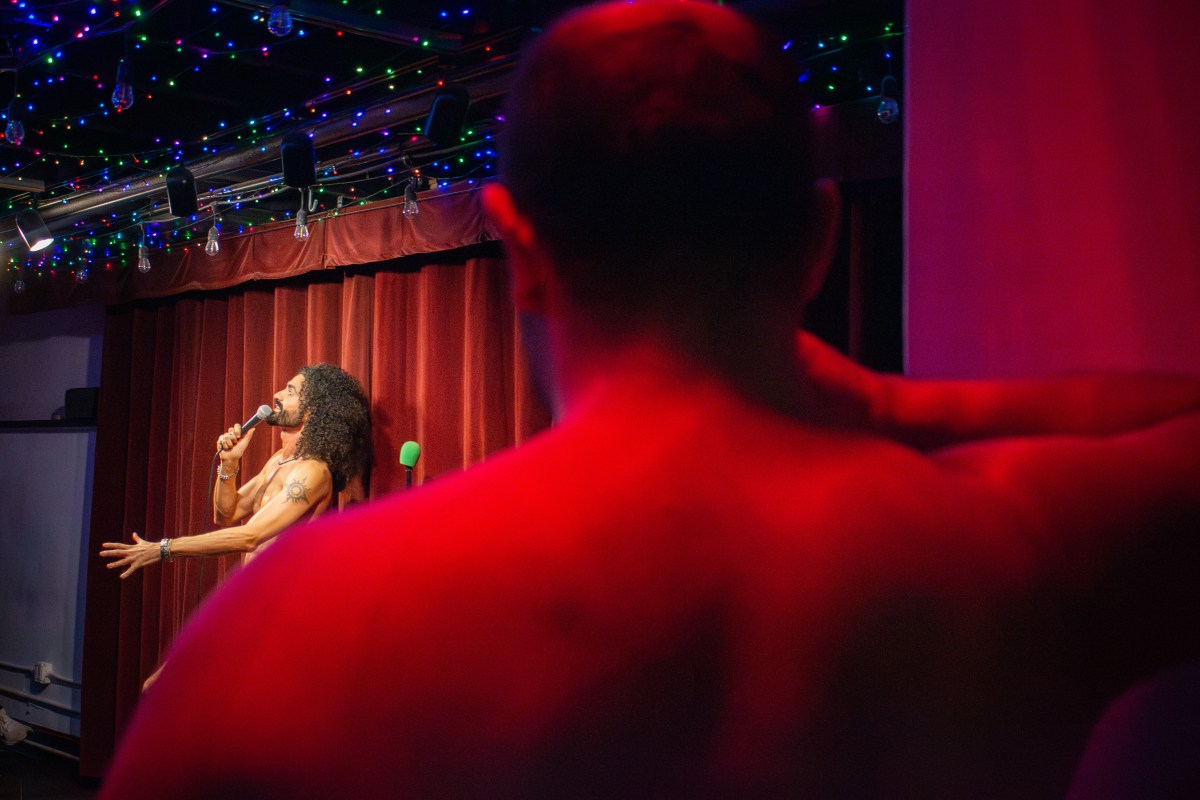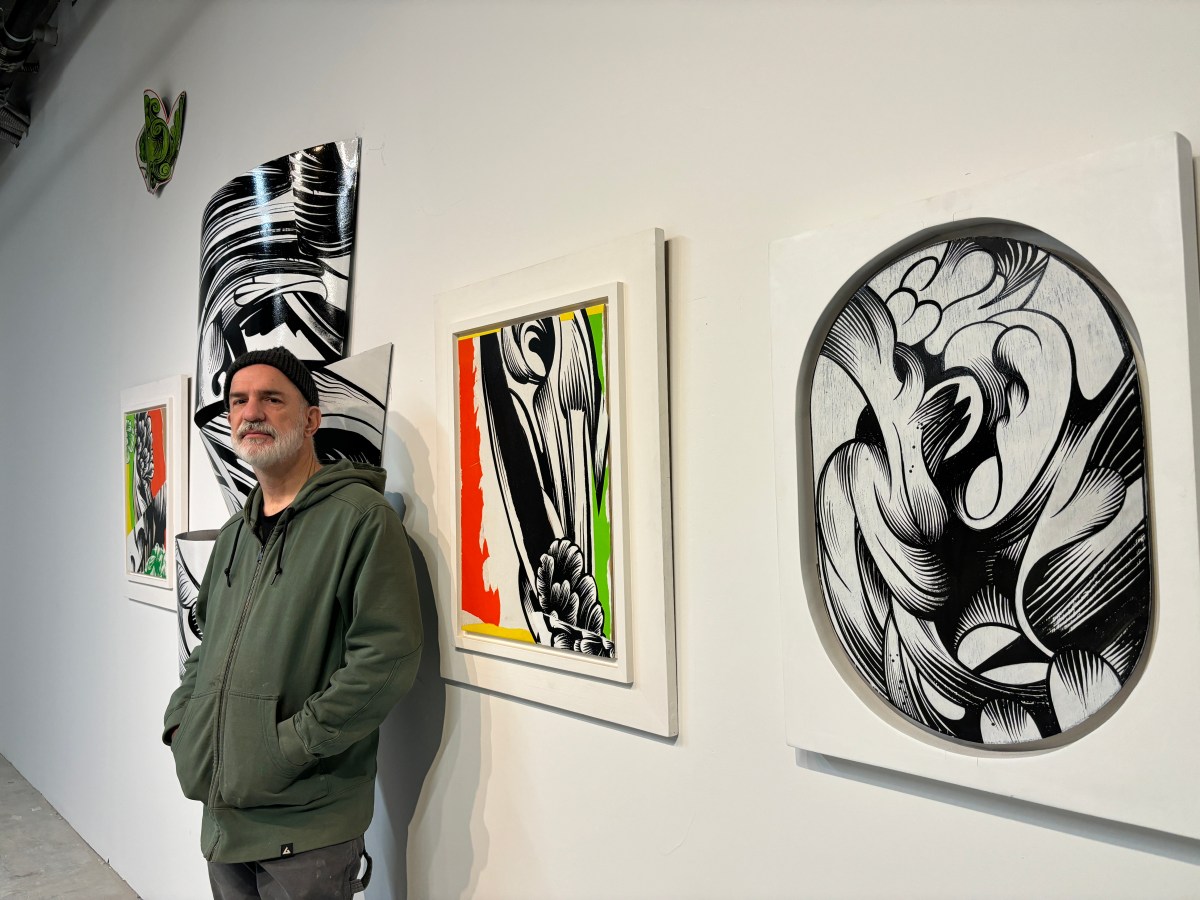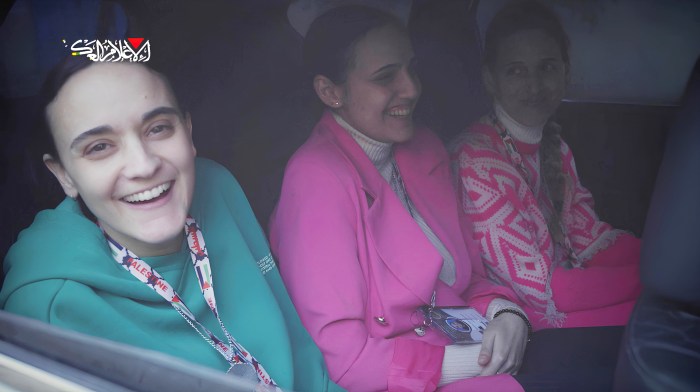By Linda Stein
Tribeca artist details the big dupe
I click onto the trailer of the upcoming 20th Century Fox movie, “Borat: Cultural Learnings of America for Make Benefit Glorious Nation of Kazakhstan,” at the urging of friends. They’re right: I’m in it. The clip shows me in my art studio in Tribeca, right near the World Trade Center site. On the wall are my female “Knights,” larger-than-life sculptures of warrior women that I created post-9/11 to evoke peace and protection, and to counter the vulnerability I felt running from the burning towers. The movie moment shows me giving Borat a heave-ho: “That’s it,” I say and walk off camera.
I made the acquaintance of Sacha Baron Cohen, the British entertainer who pretends to be a bumbling journalist from Kazakhstan, in June 2005. A blurb for the movie says “on his cross-country road-trip, Borat meets real people in real situations with hysterical consequences.” Cohen is a comedy star on HBO; predictions are he’ll make millions. I’m a visual artist, and as surprised as anyone to be headed for the big screen.
Borat is a funny guy in more than one way. He doesn’t call; he doesn’t write. He hasn’t invited me to a screening. I bet I’m not even on his party list for the Academy Awards. He doesn’t want to talk about how he induces people to engage with his fake characters. But here — from a somewhat painful first-hand experience — is how it happens.
My initial contact came from Chelsea Barnard, a name that, in retrospect, might have tipped me off to a set-up (I’m still not sure if it was real or not). In a chirpy e-mail, Chelsea said she heard about me because I am on the large board of Veteran Feminists of America, a New York group that highlights the successes and history of women leaders such as Bella Abzug, Betty Friedan and Coretta Scott King. My role with the group has been to mount shows of my works to engage people in the arts at public events.
Chelsea said she was working on “a documentary-style film about America” —although by this definition, “The Daily Show” is a documentary, too. “We are working in conjunction with Belarus Television and a foreign correspondent,” Chelsea wrote, covering up even the fictional nationality of Borat. She wanted to arrange “a round table discussion about the recent history of feminism.” Members of the producing team have worked on productions about women war correspondents and female boxers, she reported.
As a former teacher in the arts, I often extend myself to talk to younger generations and people from afar, and have even traveled to Japan to talk about women artists. When I said I would consider participating, Chelsea rushed to my studio. A dark-haired “LonelyGirl15” type, she was earnest in a pre-interview. One question was odd: What television shows do I watch? I later learned that Borat/Cohen doesn’t like encounters with people who know that he’s the guy from “Da Ali G Show.”
The filming was scheduled so rapidly that I had little time to investigate. A six-person crew and Chelsea arrived the next morning to interview me and two others, although Borat was not with them. I was on the Internet at the time, checking a friend’s assessment of the banal-sounding company listed on Chelsea’s card, One America Productions. “It looks like a front,” she said, suggesting a right-wing cover. “Ask who their funders are,” said another. There was no mention of 20th Century Fox, Borat, Cohen, or a comic movie-in-the-making.
As the crew — obviously professional — set up in my art studio, “Chelsea” handed me a contract. I asked more questions. Chelsea said the funding comes from Belarus Television and deftly clicked my computer to its website. She further persuaded me about the value of the project: she said that they were interviewing former Mayor Ed Koch. As an extra step of precaution, I decided to put in a call to his office, and Koch’s secretary, Mary, confirmed that this was true.
I finally agreed, although I admit that I failed to read the fine detail on the “Standard Consent Agreement.” Since I thought this was a documentary, I probably would have signed it anyway. When I did study it later, I realized that it’s anything but “standard.” Buried are statements asserting that I waive claims for “offensive behavior” and “misleading portrayal” and “fraud (such as any alleged deception or surprise about the film or this consent agreement).” While I’m no legal expert, I can’t believe that you can agree to be defrauded — or wouldn’t every used car dealer use the same clause?
Chelsea paid me the grand sum of $200 — cash — for my appearance. Since I’m fairly successful as an artist, the amount of money didn’t concern me, but the payment convinced me that the project had backing and wouldn’t be a waste of my time. She also paid me another $250 for the use of my premises. Chelsea left and finally, Borat showed his face, bounding into my studio, rumpled suit and all.
The fake journalist began legitimately, asking me to describe my sculptural torsos. These works of Women Warriors draw upon iconic female figures, including Wonder Woman, a character who emerged in the midst of World War II “to further the cause of peace, equality and security in a world that seems to be spiraling madly toward perpetual war,” according to original DC Comics introduction. As I pointed out the various materials in the work — wood, metal and stone — Borat listened closely.
But it wasn’t long before the fake journalist started switching and baiting, performing like a Howard Stern wannabe. Women in his country must walk behind men, he said. Condoleezza Rice is the “chocolate lady,” he claimed, implying that she beds foreign diplomats. He gestured his interest in large-breasted women. His goading produced predictable results. Right before I kicked him out, he declared — as the clip shows — that women have smaller brains than men.
In humor or art theory, you could argue that his statement is so ridiculous that the very utterance of it proves the reverse, and therefore is an unmasking of his character’s small mindedness. Some of Borat’s most famous segments do just that, such as when the comic, who is Jewish, cajoles patrons in a country-western bar to sing “Throw the Jew down the well” to expose covert anti-Semitism. But what exactly is he trying to unmask when he ridicules women?
Borat could cause a sensation by pressing his “small brain” commentary on people like Lawrence Summers, the former president of Harvard who resigned after saying that women can’t be scientists. Instead, for the sake of a cheap laugh, he chooses to reinforce the stereotype of women as the inferior sex, at the expense of women. How funny is that?
Inspired segments of Borat and me were cut. At one point, Borat declared that men are stronger than women and held up two chairs to prove it. I did, too — although I’m only half his size, I’m used to working with bronze and hefty sculpting materials, so his pecs didn’t hold up his thesis. But, clearly, he will only show segments that make the “figures” in his art — his interviewees — look foolish, so that he looks superior.
My art confronts fears and overcomes them with symbols of empowerment. I don’t know what motivates Borat/Cohen to use his considerable talents to deceive and manipulate: maybe it’s his way of gaining power over the childhood sting of religious animosity or the feelings of inferiority from a woman’s beating him at Scrabble. I only know that afterward, I am left feeling confused and sad.
After I threw Borat and his crew out to the hollow landscape of Ground Zero, I returned to my studio. Here my Wonder Woman figures welcomed me as I began, again, to work on my sculpture. Perhaps one of my future female Knights will carry an added layer of protection against celluloid tricks. Maybe then, Borat will send me the outtakes.
Linda Stein is an artist living in New York. Her exhibition on Women Warriors and the Power to Protect opens at Flomenhaft Gallery, 547 W. 27th Street in Chelsea, on November 2 and continues through December 20.





























